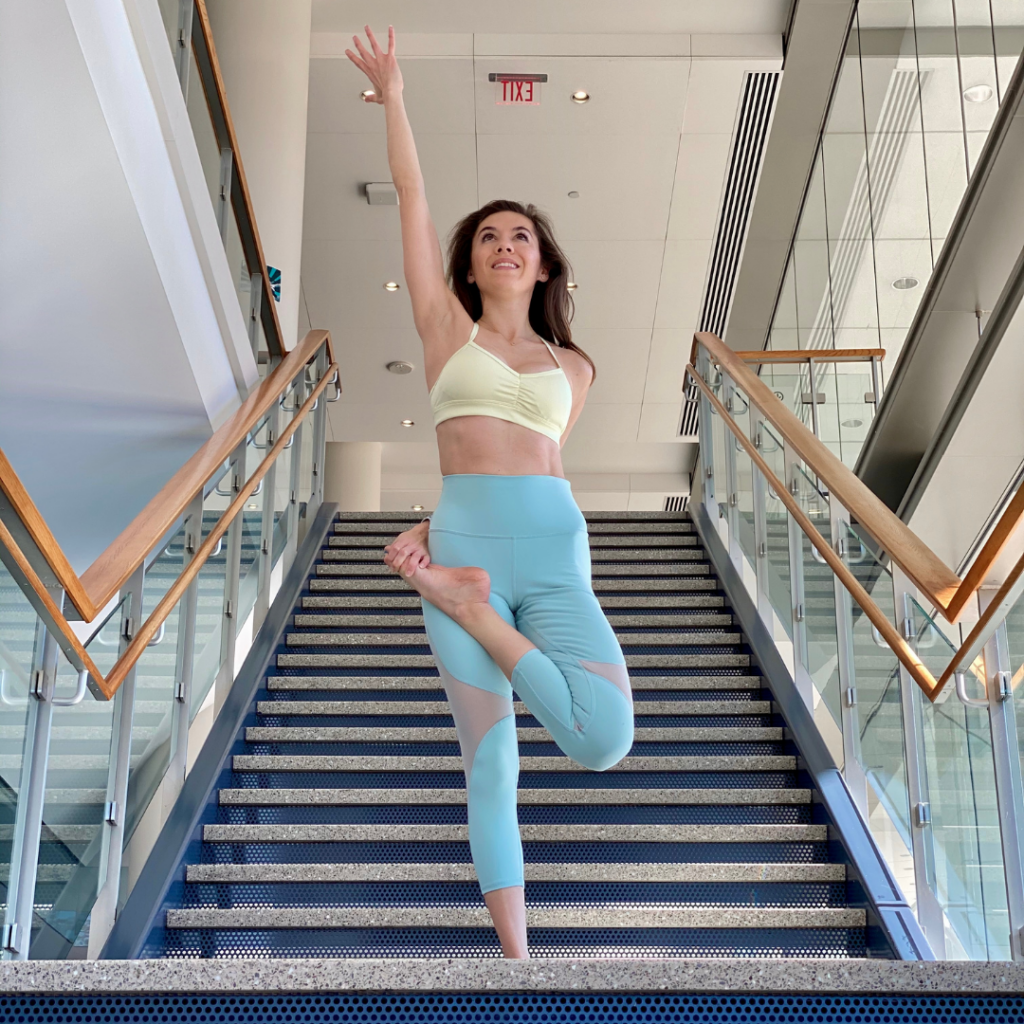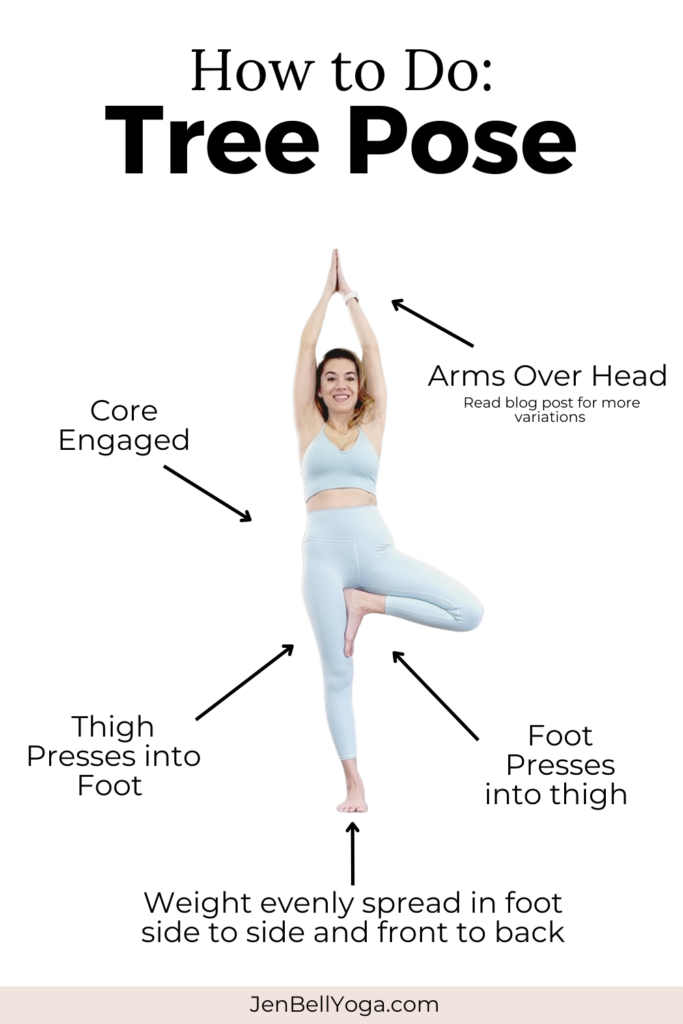
It’s simple. It’s boring. But I love to make it dance! Tree pose shouldn’t be overlooked, but even I get complacent when practicing Vrksasana.
It’s the first pose I think about when someone asks me how yoga can improve their balance. Its simplicity makes it the perfect introduction to practicing standing balancing poses, but even an advanced practitioner can find it challenging if they want. Watch the video for a visual telling of the pose but come back for more detailed information on Vrikshasana. In this post I’ll go over the basics of the pose, ways to modify, ways to challenge, and as requested – the anatomy of Tree Pose.
The trickiest part to tree pose is to hold it without falling over. Oftentimes there is a correlation between the mental activity in your mind and your ability to hold steady on one foot. In a yoga class balancing poses are generally placed in the middle. The first part of the class is meant to warm up the body and help clear the mind before attempting to balance on the feet or the hands. My suggestion is to read this post (or follow along with the video), absorb all the information you can, but know that this run through of tree pose will probably not be your best and that is OK. The next time you do vrksasana in a yoga class apply the information you found here and see how it can make a difference. 🙌
or
** Reading Break ** This blog post DOES contain affiliate links of related products I love and they might even be pictured. If you click on a link and purchase a product (or service) it costs you nothing, you MIGHT even get a discount, and I MAY even receive a SMALL commission. This helps me to buy and drink coffee ☕️ in order to keep me awake and provide you with amazing free content 💗 Thank You for supporting my content 💋
Having a hard time holding tree pose? Take a look at the surface you’re standing on. Tree pose could be done on any surface, but a flat firm surface is easier to balance on than even a yoga mat. Below is a list of surfaces going from easiest to most challenging. If you find tree pose easy, work your way through the list to increase your ability to balance.
Sometimes you’ll see a funky flow into (or out of) tree pose, but traditionally it’s done from mountain pose at the top of the mat. Below are the instructions from that, but there is no one right way to move into this pose. The important thing? Is to always be present and mindful as you move into any pose.
or
To come out of the pose, place the lifted foot back down on the ground coming back into mountain pose.
Sign up for my newsletter and get information on various poses as well as yoga therapy practices to help you live your best life. Privacy is important, I won’t sell your info, I promise.

Balance can be difficult for many reasons: medication, inner ear issue, lack of mobility in the foot, lack of strength in the leg, weak proprioception, and more. The above quote almost says it all: you don’t magically start balancing, you have to practice (cultivate) it in order to attain balance. I’m guessing the quote above is in relation to life (work/life balance), but the same can be applied for physical balance. As babies we don’t come out walking. Our first steps are often filled with constant teeter and toddling followed by a few splats. So, if you’re struggling to find physical balance here are some suggestions:
No matter the reason, you may have an injury, it might be uncomfortable, or you just don’t want to do it, you don’t HAVE to do traditional arms in tree pose. You can put your arms in a variety of positions. Below is a list to start from, some (but not all) of these are shown in the video. You can get creative and combine arm positions from other poses to get a stretch in and avoid tension where it’s needed.
The purpose of tree pose is to practice balancing on one leg, what happens with the other leg is nearly irrelevant to the purpose of the pose. Traditionally the lifted foot is on the inner thigh of the supporting leg but it isn’t mandatory to meet the purpose of the pose. Below is a list of other ideas for the lifted leg. It’s not exclusive and you can be as creative as you would like.
I had a hard time titling this section. Yoga is a process and a practice, it’s not about perfecting anything, so it’s hard for me to call these “mistakes.” In reality this is about things to look out for, or things to explore. You may not be aware there’s anything to adjust, but if you have a spare minute grab your phone (or a mirror) and record, then watch yourself in the pose. Take the video from both a front and a side angle to get the most information. The below “mistakes” are probably easier to watch, so if you haven’t yet, watch the video to get the most of the section below.
I catch myself doing this often, especially when I’ve been sitting a lot. The flexed hip position (think when they’re sitting in a chair) is something we do so often we become very comfortable with how it feels. This is simple to correct: engage your gluteus maximus. The glute max (the big butt muscle) prevents hip flexion. Notice as you engage it how you start to stand up taller.
If you squeeze your glute but relax your core you’ll make the opposite shape: hips forward and a small arch in your low back. So make sure you squeeze your glutes while engaging your core.
I have given this as a yoga therapy exercise to a few clients of mine. It’s a great way to make sure you’re engaging your gluteus medius. Sassy tree is when you stick the hip of the support leg out to the side. Generally the hips are no longer parallel to the ground, and the hips are also not centered over the supporting leg foot. So as you’ve already figured out, the way to correct this posture is to engage the gluteus medius. If you want to do my sassy tree exercise just move back and forth between a sassy tree and a standard tree. You’ll feel that glute med start to burn after a few reps!
If you’re not finding tree pose challenging enough here are a few ways to challenge tree pose:

I introduced these next two sections 2 weeks ago. These sections can be helpful if you’re going through a yoga teacher training, a medical professional, or if you’re just curious about how the poses work. As I mentioned during side angle pose: anatomy is complex but the goal here is to hit the big points.
Love anatomy? Want to know how to apply it to the pose, or what pose can do what to your body? Here’s the breakdown of the pose by the anatomy.
I don’t practice tree pose very often. Actually, take that back. I often stand around on one leg, with my hip sticking out, and my other foot pressing on my inner thigh. Just like that sassy tree I wrote about up there 👆. Hopefully from this post and the video you learned a few ways to find more stability in your tree pose, or a renewed sense of fun with new challenging variations. Sign up for my newsletter below to learn more tips and tricks on (and the anatomy of) all your favorite yoga poses.
Find out what’s going on… You know you want to… Privacy is important, I won’t sell your info, I promise.
